Most unreliable and most inferior Electrolytic (Bad and Leaked) Caps - Overview wanted of affected CD-Player, DAC and Amps
Here are threads concerning overviews of capacitor manufacturers:
List of Bad Cap Manufacturers - Badcaps Forums
Be aware of Fake Capacitors. : electronics
and
Most and Least Reliable Electrolytic Capacitors | Page 2 | Audio Science Review (ASR) Forum
but I want to have an overview of audio components like CD DAT DA-converter and all kind of amps that have one of these capacitor brands built in.
This is important to know before one purchase anything in used condition.
I remember this straight away:
1) Kenwood: Even with audio devices that were already released in the early 90s, a short time later one had to deal with heavily oxidized conductor tracks due leaked ELNA electrolytic capacitors - see images of Kenwood's CD player models DP7030 or DP5030 in the attachment and under
Klassiker-Service - DP-7030
2) Sony CD Player ESPRIT (e. g. motor control for spindle motor) - leaked caps (mostly SMD versions without brand name) and broken connection between conductor tracks from top (component side) to bottom (solder side) of PCB
3) Philips e. g. DCC-900
DCC900 Capacitor replacement - Recorders, Players, etc. - DCC Museum Forum
https://www.audiovintage.fr/leforum/viewtopic.php?t=14466&start=20
P.S.: The idea to start this thread comes in my mind after reading post #7-14 under
Audiolab M-DAC Inside/PCB
Here are threads concerning overviews of capacitor manufacturers:
List of Bad Cap Manufacturers - Badcaps Forums
Be aware of Fake Capacitors. : electronics
and
Most and Least Reliable Electrolytic Capacitors | Page 2 | Audio Science Review (ASR) Forum
but I want to have an overview of audio components like CD DAT DA-converter and all kind of amps that have one of these capacitor brands built in.
This is important to know before one purchase anything in used condition.
I remember this straight away:
1) Kenwood: Even with audio devices that were already released in the early 90s, a short time later one had to deal with heavily oxidized conductor tracks due leaked ELNA electrolytic capacitors - see images of Kenwood's CD player models DP7030 or DP5030 in the attachment and under
Klassiker-Service - DP-7030
2) Sony CD Player ESPRIT (e. g. motor control for spindle motor) - leaked caps (mostly SMD versions without brand name) and broken connection between conductor tracks from top (component side) to bottom (solder side) of PCB
3) Philips e. g. DCC-900
DCC900 Capacitor replacement - Recorders, Players, etc. - DCC Museum Forum
https://www.audiovintage.fr/leforum/viewtopic.php?t=14466&start=20
P.S.: The idea to start this thread comes in my mind after reading post #7-14 under
Audiolab M-DAC Inside/PCB
Attachments
-
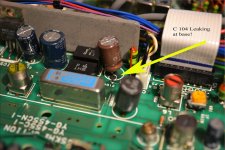 16160306256_eb494e4f99_b.jpg198.8 KB · Views: 688
16160306256_eb494e4f99_b.jpg198.8 KB · Views: 688 -
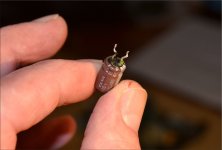 16000684537_31426223c4_b.jpg87.8 KB · Views: 630
16000684537_31426223c4_b.jpg87.8 KB · Views: 630 -
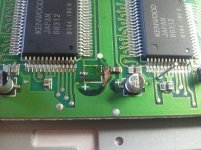 2012-06-16-09-44-30.jpg487.5 KB · Views: 635
2012-06-16-09-44-30.jpg487.5 KB · Views: 635 -
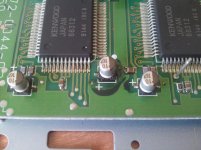 2012-06-16-09-20-22.jpg431.4 KB · Views: 622
2012-06-16-09-20-22.jpg431.4 KB · Views: 622 -
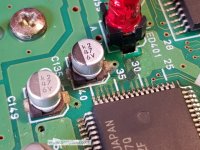 PCE-Capleak-1.jpg321.8 KB · Views: 644
PCE-Capleak-1.jpg321.8 KB · Views: 644 -
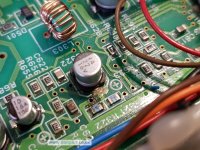 PCE-Capleak-2.jpg396 KB · Views: 359
PCE-Capleak-2.jpg396 KB · Views: 359 -
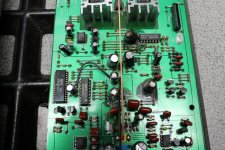 gupu71Ih.jpg175.6 KB · Views: 297
gupu71Ih.jpg175.6 KB · Views: 297 -
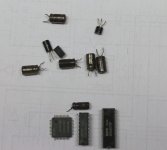 GdVaSHMh.jpg51.9 KB · Views: 287
GdVaSHMh.jpg51.9 KB · Views: 287 -
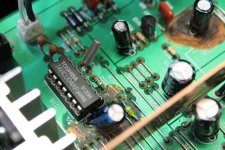 fJI9wyYh.jpg120 KB · Views: 281
fJI9wyYh.jpg120 KB · Views: 281 -
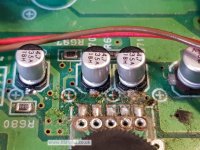 PCE-Capleak-4.jpg341.4 KB · Views: 338
PCE-Capleak-4.jpg341.4 KB · Views: 338
Last edited:
You can look this up in old information of the bad cap period (you know, the story of the stolen formula of water based electrolyte for ultra low ESR caps). When this ended tens of millions of bad caps had been produced and were used even in military stuff. These turned up now and then with new sleeves and new brand names but will then fail years later  It came back again at Nichicon (this time an A brand) years later. Old news. Today it still occurs with cheap devices that have ultra low cost Chinese electrolytic capacitors....sometimes disguised as fake A branded capacitors. Some of the old offenders have become normal brands (Lelon) and many are still around and still produce mediocre stuff. Electrolytic capacitors are a nuisance as they are an important part of the cost in consumer electronics so this is where cost reductions take place. If you train yourself to look at suspicious brands you can decide to leave the device and not obtain it. The cap quality defines the devices quality and failure rate for a large part!
It came back again at Nichicon (this time an A brand) years later. Old news. Today it still occurs with cheap devices that have ultra low cost Chinese electrolytic capacitors....sometimes disguised as fake A branded capacitors. Some of the old offenders have become normal brands (Lelon) and many are still around and still produce mediocre stuff. Electrolytic capacitors are a nuisance as they are an important part of the cost in consumer electronics so this is where cost reductions take place. If you train yourself to look at suspicious brands you can decide to leave the device and not obtain it. The cap quality defines the devices quality and failure rate for a large part!
It maybe makes more sense to reverse the logic and to to replace all unknown and in your case old caps anyway for known good brands. My selection criterium is to replace caps older than 10 year. Secondly to check devices (inside pictures as published online) before obtaining them and steer clear if they are full of non A branded electrolytic caps certainly when there are very much of these used. Supposedly "better" audio often fails earlier than normal. Whether devices are bought brand new or second hand does not make much of a difference, the bad caps will cause premature failure anyway regardless if the device is in possession of the first or the second owner.
Even more effective is to leave old CD players for what they are, don't look back into the past as lasers are difficult to find and the cap issues also add up. New CD players are often also not of the desired quality and IMO worse than good CDM based devices. Then a simple streamer or audio player makes more sense. Better sound quality, high chance of good electrolytic caps, no laser, lower cost, enhanced possibilities. Choosing nostalgia will cost you money and time.
The best chances are for stuff that is produced in the millions as then manufacturers will design carefully as a recall can mean their bankruptcy.
It maybe makes more sense to reverse the logic and to to replace all unknown and in your case old caps anyway for known good brands. My selection criterium is to replace caps older than 10 year. Secondly to check devices (inside pictures as published online) before obtaining them and steer clear if they are full of non A branded electrolytic caps certainly when there are very much of these used. Supposedly "better" audio often fails earlier than normal. Whether devices are bought brand new or second hand does not make much of a difference, the bad caps will cause premature failure anyway regardless if the device is in possession of the first or the second owner.
Even more effective is to leave old CD players for what they are, don't look back into the past as lasers are difficult to find and the cap issues also add up. New CD players are often also not of the desired quality and IMO worse than good CDM based devices. Then a simple streamer or audio player makes more sense. Better sound quality, high chance of good electrolytic caps, no laser, lower cost, enhanced possibilities. Choosing nostalgia will cost you money and time.
The best chances are for stuff that is produced in the millions as then manufacturers will design carefully as a recall can mean their bankruptcy.
Last edited:
Once I used a brand of low cost OEM switch mode power supplies. Then they started dying at an alarming rate, especially when running at 230V.... I got some back and took them apart, and as I suspected, dead electrolytic capacitors.... Looked up the parts and actually located the chinese manufacturer, it turned out the part was specified at a lifetime of 1000 hours at 85 deg C.... Didn't know anybody made such crappy capacitors, before that I have never seen specs less than 2000 hours...
Switched supplier and specified 105 deg Japanese capacitors.... Nowadays you can get pretty good electrolytic capacitors that last for many years, just keep the temperature down.
Switched supplier and specified 105 deg Japanese capacitors.... Nowadays you can get pretty good electrolytic capacitors that last for many years, just keep the temperature down.
Last edited:
Yes the people that produce stuff and include ready made OEM SMPS like them as it takes work out of their hands and it saves certifications etc. and ... it saves a mains switch. In practically most consumer electronics one can be sure the SMPS will fail, now please tell me how many linear PSU's die compared to that  You may include 20 year old ones in the equation. There are a lot of plain bad SMPS and sometimes one spots the odd good (hooray!) SMPS in consumer electronics but rest assured, not many of either of them will reach 20 year lifetime
You may include 20 year old ones in the equation. There are a lot of plain bad SMPS and sometimes one spots the odd good (hooray!) SMPS in consumer electronics but rest assured, not many of either of them will reach 20 year lifetime  IF they do they have caused EMI for 20 years as well.
IF they do they have caused EMI for 20 years as well.
@tiefbassuebertr: making an extensive a list of all devices that have bad caps is contraproductive as age often already demands replacement. Secondly one can check a device online and the list will only be useful to commercial guys (let those do the job). So 2 factors. It is also putting work in old worn out stuff with the sex appeal of a refridgerator. Selecting a current device on said properties is easier with better results like high res etc.
@tiefbassuebertr: making an extensive a list of all devices that have bad caps is contraproductive as age often already demands replacement. Secondly one can check a device online and the list will only be useful to commercial guys (let those do the job). So 2 factors. It is also putting work in old worn out stuff with the sex appeal of a refridgerator. Selecting a current device on said properties is easier with better results like high res etc.
Last edited:
Bravo jean-paul!
You think like I do.
These kids can have their "new age" SMPS to play with and take chances with.
That is their choosing.
Every amp/product that I make is Old School linear design PS.
And every Long Lived product is built the same way.
Experience brings wisdom.
You think like I do.
These kids can have their "new age" SMPS to play with and take chances with.
That is their choosing.
Every amp/product that I make is Old School linear design PS.
And every Long Lived product is built the same way.
Experience brings wisdom.
The reserve power of a linear PS cannot be matched by SMPS, and yes, rare to see 15 year old computer SMPS which has not seen repair or failure.
Linear PS? After many years, the caps may need attention...if they are wax capacitors in an old tube radio, I doubt they have a high failure rate.
Here DVD drives are about 1000 Rupees, old ones 300 to 400, and not even belts for the tray are available, forget lasers.
Better to store your stuff on digital media, or on line.
With the arrival of on line streaming, cheap data, and personal hi fi like head phones, the entire audio experience is going through a change.
You can stream audio from your cell phone to your stereo, and that can be at home, work, car, wherever...
Now I see higher rated SMPS with smaller heat sinks than the old ones, a clear indication of cost cutting.
And I could tell you stories about stuck fans with dry lubrication, and shorted PCBs due to moisture and dust getting together. Result is a panic service call, and at times a damaged hard disk.
I coat SMPS PCBs with spray or varnish, whenever i get them, at times brand new after telling the supplier I am breaking the seal. So far, on Meanwell supplies, no need for warranty claims, they are well made.
Still prefer linear supplies.
Linear PS? After many years, the caps may need attention...if they are wax capacitors in an old tube radio, I doubt they have a high failure rate.
Here DVD drives are about 1000 Rupees, old ones 300 to 400, and not even belts for the tray are available, forget lasers.
Better to store your stuff on digital media, or on line.
With the arrival of on line streaming, cheap data, and personal hi fi like head phones, the entire audio experience is going through a change.
You can stream audio from your cell phone to your stereo, and that can be at home, work, car, wherever...
Now I see higher rated SMPS with smaller heat sinks than the old ones, a clear indication of cost cutting.
And I could tell you stories about stuck fans with dry lubrication, and shorted PCBs due to moisture and dust getting together. Result is a panic service call, and at times a damaged hard disk.
I coat SMPS PCBs with spray or varnish, whenever i get them, at times brand new after telling the supplier I am breaking the seal. So far, on Meanwell supplies, no need for warranty claims, they are well made.
Still prefer linear supplies.
Last edited:
In practically most consumer electronics one can be sure the SMPS will fail
Such negativity! It's the future!
When i was 18 i bought a brand new "futuristic" Sony amp. It had a heat pipe and an smps. The heat pipe kind of lasted but the smps blew up almost immediately. And yes, it was the worst sounding amp i had heard at the time.
Interestingly, the smps had its own sealed metal case, as if bad demons were contained inside. A gazillion screws to open it. Don't remember seeing such noise paranoia in more recent consumer equipment.
It was the future in 1980 and still is

Of course I think positive but experiences are mostly negative. If one sees failure and substandard performance a natural reaction can be to go for quality stuff. Quality stuff that has nothing to do with the brand name one will soon notice.
Please note that we talk consumer electronics, not pro stuff which is an entirely different situation. I see A branded source devices where the SMPS has failed. There is no valid technical reason to use SMPS under 25 VA, it is only commercial reasons in practice. So why would I defend a choice that defines premature failure and EMI, RF radiation when I am in the hobby for best results? It is simply frustrating to have devices that fail when they're just over their second birthday. Less than a year ago I saw containers full of SMPS at an Internet provider all belonging to cable modems, routers and such. All suffering from bulging caps and this in 2020...This way of working (and accepting or worse defending it!) is the least imaginable green way. Designing simple good quality devices is greener. It is not about linear versus SMPS (the latter suffer extra from cost cutting), it is (for me) about being able to trust stuff and have best performance.
So instead of loosing time on old worn out or defective stuff and staying in a negative circle of required repairs and replacing 1000s of Chinese caps I focus to filter out the real good stuff in modern consumer electronics. Sometimes one needs to replace a cap here and there. For this approach I sometimes open a thread here on "new" devices and what can be done to prolong their lifetime and/or to improve results. New technology, new challenges, playing chess with modern designers and their choices...
Please note that we talk consumer electronics, not pro stuff which is an entirely different situation. I see A branded source devices where the SMPS has failed. There is no valid technical reason to use SMPS under 25 VA, it is only commercial reasons in practice. So why would I defend a choice that defines premature failure and EMI, RF radiation when I am in the hobby for best results? It is simply frustrating to have devices that fail when they're just over their second birthday. Less than a year ago I saw containers full of SMPS at an Internet provider all belonging to cable modems, routers and such. All suffering from bulging caps and this in 2020...This way of working (and accepting or worse defending it!) is the least imaginable green way. Designing simple good quality devices is greener. It is not about linear versus SMPS (the latter suffer extra from cost cutting), it is (for me) about being able to trust stuff and have best performance.
So instead of loosing time on old worn out or defective stuff and staying in a negative circle of required repairs and replacing 1000s of Chinese caps I focus to filter out the real good stuff in modern consumer electronics. Sometimes one needs to replace a cap here and there. For this approach I sometimes open a thread here on "new" devices and what can be done to prolong their lifetime and/or to improve results. New technology, new challenges, playing chess with modern designers and their choices...
Last edited:
I agree that nowadays a big part of consumer electronic fails due to failing smps. And you find these crap not only inside nameless far-East electronics but in formerly well reputated brands like Teufel, JBL, Harman Kardon just to name a few. And this is not a problem of smps technolgy per se, but a low quality problem. I can say so having repaired lots of smps. Building long lasting smps is no rocket science, but nobody is interested. We produce a growing global pile of consumer electronics crap nobody really needs.
You prove the point. What is supposedly is "gained" with regards to the high efficiency is lost when they turn out to be throw away devices. Many an old device with linear PSU simply had a sturdy mains switch which assured 0 kWh were consumed when the device was not in use.
Long lasting SMPS can be designed but are not found in consumer stuff. So purely theoretical positive features are mainly vaporware in practice. The "growing global pile of consumer electronics crap nobody really needs" is worse for the environment than the old system. If one brings stuff to recycling centers now and then one sees devices made decades ago being recycled not because they failed but because the owner assumes the device to be useless/outdated. You can be sure that todays electronics won't last 5 years.
Long lasting SMPS can be designed but are not found in consumer stuff. So purely theoretical positive features are mainly vaporware in practice. The "growing global pile of consumer electronics crap nobody really needs" is worse for the environment than the old system. If one brings stuff to recycling centers now and then one sees devices made decades ago being recycled not because they failed but because the owner assumes the device to be useless/outdated. You can be sure that todays electronics won't last 5 years.
Last edited:
Next problem is all that accu driven stuff. If you care for them, 10..15yrs they are done, and if you forget it may take 2 yrs for LiIon. Digicams, BT-speakers, tools... They all incorparate custom-built accus that in most cases cannot be replaced by customer. I am just throwing away a Canon and an Olympus Digicam for that reason.
Thanks for reminding me  BTW on topic again: devices with bad capacitors and SMPS with leaking/bulging caps of course can be repaired/equipped with known good electrolytic capacitors but when the number is very high and PCB tracks either peel off quickly or when the board is 4 layer then the turning point of discarding it is reached quickly as well. So it really would be better to use some selection criteria when buying devices. Avoiding seems more efficient than curing.
BTW on topic again: devices with bad capacitors and SMPS with leaking/bulging caps of course can be repaired/equipped with known good electrolytic capacitors but when the number is very high and PCB tracks either peel off quickly or when the board is 4 layer then the turning point of discarding it is reached quickly as well. So it really would be better to use some selection criteria when buying devices. Avoiding seems more efficient than curing.
Last edited:
I spent 25 years running a busy repair shop, servicing just about every consumer audio AND video product manufactured from 1929 up to current times.
I even serviced computers of various ages, along with industrial and medical equipment brought in for service.
A part of my specialty work was doing restorations on vintage audio, radio too.
I became an expert on every type of turntable and record changer and tape deck over the years as well.
So I've seen a lot more than what the average person on this and other sites has had experience with.
10's of thousands of products!
All of which gave me quite a bit of insight into the industry, the brand names, and how things changed over the decades.
Bucks bunny and jean-paul both have good points, and would understand what I went through day after day and month after month.
Indeed, brand names have lost their long time credibility due to cheapening, in many cases.
And yes, this capacitor quality thing is a part of it, but also some things like cost-cutting, lack of heatsinking, and some design errors as well.
These issues are mainly born in relatively new products since the early 90's, as I watched the overall quality drop.
Does anyone remember the VCR's that had linear supplies? - around 1975 to 1985.
They were monsters, and had durable metal mechanism designs as well.
They were a joy to service if needed.
Then came the newer, lighter, streamlined models with SMPS..... and more plastic parts.
These came into the shop with greater speed, and more aggrevation to fix.
And Rotel, who among others, once made great quality audio, started using conductive glues to hold parts in place, and again brought a new kind of servicing to my bench.
I never had to scrape and flush nasty glue from old products.
Of special mention is those chinese made HDMI boards in AV receivers of most brands - even "high end" brands..... a real pain to deal with, with customers highly annoyed at the repair costs.
In a way, I'm glad to be retired from all that crap, it gave me plenty of grey hair and aggrevation.
I even serviced computers of various ages, along with industrial and medical equipment brought in for service.
A part of my specialty work was doing restorations on vintage audio, radio too.
I became an expert on every type of turntable and record changer and tape deck over the years as well.
So I've seen a lot more than what the average person on this and other sites has had experience with.
10's of thousands of products!
All of which gave me quite a bit of insight into the industry, the brand names, and how things changed over the decades.
Bucks bunny and jean-paul both have good points, and would understand what I went through day after day and month after month.
Indeed, brand names have lost their long time credibility due to cheapening, in many cases.
And yes, this capacitor quality thing is a part of it, but also some things like cost-cutting, lack of heatsinking, and some design errors as well.
These issues are mainly born in relatively new products since the early 90's, as I watched the overall quality drop.
Does anyone remember the VCR's that had linear supplies? - around 1975 to 1985.
They were monsters, and had durable metal mechanism designs as well.
They were a joy to service if needed.
Then came the newer, lighter, streamlined models with SMPS..... and more plastic parts.
These came into the shop with greater speed, and more aggrevation to fix.
And Rotel, who among others, once made great quality audio, started using conductive glues to hold parts in place, and again brought a new kind of servicing to my bench.
I never had to scrape and flush nasty glue from old products.
Of special mention is those chinese made HDMI boards in AV receivers of most brands - even "high end" brands..... a real pain to deal with, with customers highly annoyed at the repair costs.
In a way, I'm glad to be retired from all that crap, it gave me plenty of grey hair and aggrevation.
Last edited:
absolutely agreed. Harman is another such extreme example compared to previous products go to
DS-15 Class-D Modul with much Trouble and used in a lot of Models from Harman//JBL
and
Harman Kardon "Citation" Series - complete Overview wanted
DS-15 Class-D Modul with much Trouble and used in a lot of Models from Harman//JBL
and
Harman Kardon "Citation" Series - complete Overview wanted
absolutely agreed. Harman is another such extreme example compared to previous products go to
DS-15 Class-D Modul with much Trouble and used in a lot of Models from Harman//JBL
and
Harman Kardon "Citation" Series - complete Overview wanted
The Polk subwoofers are another short-lived mess with SMPS supplies that crap out.
- Home
- Design & Build
- Parts
- Most unreliable and most inferior Electrolytic (Bad) Caps - Device Overview wanted